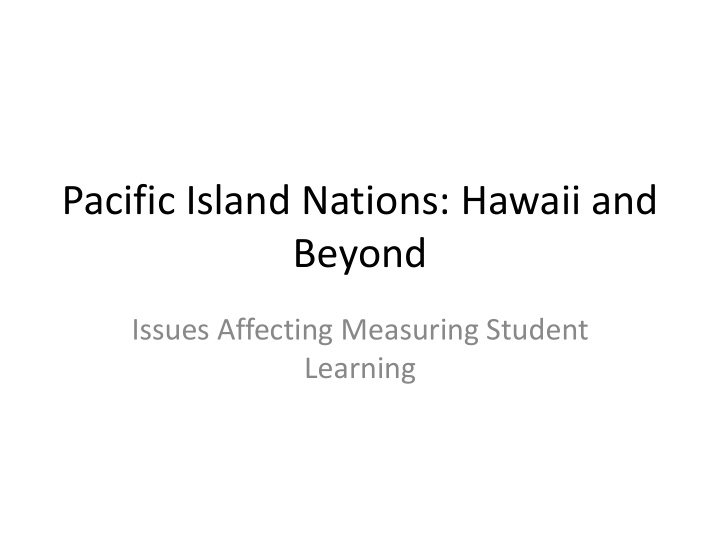



Pacific Island Nations: Hawaii and Beyond Issues Affecting Measuring Student Learning
Speakers • Robert Soliai – Assessment Director – American Samoa Department of Education • Josi Jones-Lizama – Senior Assessment Specialist – Pacific Assessment Systems and Services – Pacific Resources for Education and Learning • Chief Ray Mechol – Research and Evaluation- Republic of Palau • Mr. Stanley Heine – Assessment Specialist, Republic of the Marshall Islands • Mr. Fasefulu Tigilau- Assessment Coordinator – Commonwealth of the Northern Mariana Islands • Dr. Melly Wilson – Senior Specialist, Policy & Research - Pacific Resources for Education and Learning
Why are measurement issues important to Pacific Island Nations? • Many Pacific islanders come to the United States for jobs. Many have difficulty competing with “mainlanders” because of the quality of education in the islands. • Educational leaders in the Pacific island nationals are looking at assessment to gauge the quality of education in there schools.
Why is understanding Pacific islanders important to “mainland” schools • There are pockets of Pacific islanders in schools in Hawaii and across the mainland. • Mainland schools with Pacific island student populations struggle with educational strategies to bring these students up to “Proficient” levels.
Geographical Context
Travel/Distance/Time Entities spread across 4.9 million square miles 2,600 mi. to American Samoa (4.5 hrs. by air) 3,800 mi. to Guam (7.5 hrs. by air) 2,400 mi. to California (4.5 hrs. by air) 4,800 mi. to DC (10.5 hrs. by air) Limited airline service International date line/6 time zones
Political Context 3 Nations (Freely Associated States) Federated States of Micronesia (Chuuk, Kosrae, Pohnpei, and Yap) Republic of the Marshall Islands Republic of Palau 2 Territories Territory of American Samoa, USA Territory of Guam, USA 1 Commonwealth Commonwealth of the Northern Mariana Islands, USA 1 State State of Hawai‘i, USA
Ten Entities and Beyond •1960’s - 1980’s - Regional Educational Laboratory Program begins; NWREL serves the Pacific area • 1983 - 10th laboratory authorized • 1985 - Transition from NWREL to Pacific-based organization begins • 199O - Pacific Regional Educational Laboratory (PREL) independently funded
Cultural Context 11 major Pacific cultures Major cultural and linguistic differences English as language of instruction; may not be spoken at home
Educational Context Schools • Facilities: minimal to well-equipped buildings • Utilities: no electricity to high-tech capability • Teacher credentials: high school diploma to PhD • Policy: little to comprehensive • School materials: limited to adequate • Leadership: traditional to transformational
Students and Teachers Number of students (public schools) 285,100 Number of public schools 658 Number of teachers 19,110 Percent of teachers below BA level 45% (outside Hawai‘i)
Issues Each Entity is Striving to Overcome • assessment budgets • Few assessment related positions • Few assessment staff have an assessment back grounding thorough US DOE or Department of the Interior is a major portion of the entity educational budget • Vast distances between main and outer islands
Common Themes • Local language and customs were forbidden in schools. – Spanish language – German language – Japanese language – English language
PREL’s work is guided by . . . Historical Domination • Pre- Contact: Prior to Spanish in the 1600’s – Clan system governed by Chiefs – Some cultures are matriarchal • Spanish Period 1675- 1899 – Diseases – Christianity – Alcohol – Gun Powder • German Period 1900 – 1917 – Schools, hospitals, pubic buildings – Organized governance by Germans – Coconut plantations establish for copra
Continued • Japanese Period – 1918 - 1945 – Organized farming for copra and sugar cane – Schools for learning Japanese – WWII • US Administration – 1945 – Today – Western models of business – Western models of education – English as the primary language
Oral Language • Oral language only in pre-contact islands • Missionaries began converting oral languages to written language. • The orthography of many local languages is not complete in many entities.
Examples • There is no “P” in the Palauan Alphabet – It is “B”– Balau • The island nation of Chuuk was called Truk during WWII. • Yap has four different official languages • Lota was renamed Rota because Japanese had trouble with the “L” sound. • English has emerged as a common language for business and communication.
Distances and Communication between the main island and outer islands. • Guam is the only island nation with just one island. • Air travel is available to all Hawaiian islands but most of the other nations have to go by boat. • The Republic of the Marshall Islands have approximately – 1,225 atolls and inlets – about 115 public and private schools – 1200 students with two public high schools • Yap has approximately 600 islands and inlets. – The government boat in YAP takes 6 – 8 weeks to make the circuit among the outer islands
Cultural Heritage and Customs • Deep respect for the land and the ocean – Both provided sustenance and shelter • Clans remain very important in Pacific island culture. – Elders are shown respect – Extended families share homes • Parental expectations for education may be low.
Recommend
More recommend